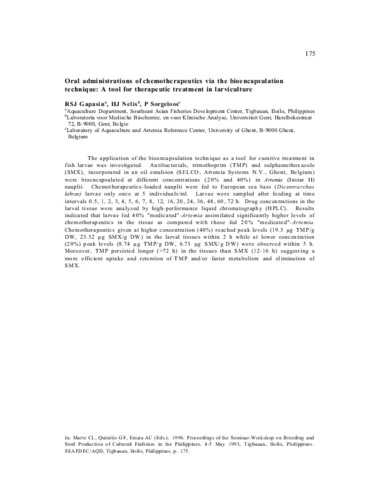Oral administrations of chemotherapeutics via the bioencapsulation technique: A tool for therapeutic treatment in larviculture
Share
Abstract
The application of the bioencapsulation technique as a tool for curative treatment in fish larvae was investigated. Antibacterials, trimethoprim (TMP) and sulphamethoxazole (SMX), incorporated in an oil emulsion (SELCO, Artemia Systems N.V., Ghent, Belgium) were bioencapsulated at different concentrations (20% and 40%) in Artemia (Instar II) nauplii. Chemotherapeutics-loaded nauplii were fed to European sea bass (Dicentrarchus labrax) larvae only once at 5 individuals/ml. Larvae were sampled after feeding at time intervals 0.5, 1, 2, 3, 4, 5, 6, 7, 8, 12, 16, 20, 24, 36, 48, 60, 72 h. Drug concentrations in the larval tissue were analyzed by high-performance liquid chromatography (HPLC). Results indicated that larvae fed 40% "medicated"-Artemia assimilated significantly higher levels of chemotherapeutics in the tissue as compared with those fed 20% "medicated"-Artemia. Chemotherapeutics given at higher concentration (40%) reached peak levels (19.3 µg TMP/g DW, 23.32 µg SMX/g DW) in the larval tissues within 2 h while at lower concentration (20%) peak levels (8.74 µg TMP/g DW, 6.73 µg SMX/g DW) were observed within 5 h. Moreover, TMP persisted longer (>72 h) in the tissues than SMX (12-16 h) suggesting a more efficient uptake and retention of TMP and/or faster metabolism and elimination of SMX.
Suggested Citation
Gapasin, R. S. J., Nelis, H. J., & Sorgeloos, P. (1996). Oral administrations of chemotherapeutics via the bioencapsulation technique: A tool for therapeutic treatment in larviculture. In C. L. Marte, G. F. Quinitio, & A. C. Emata (Eds.), Proceedings of the Seminar-Workshop on Breeding and Seed Production of Cultured Finfishes in the Philippines, Tigbauan, Iloilo, Philippines, 4-5 May 1993 (p. 175). Tigbauan, Iloilo, Philippines: Aquaculture Department, Southeast Asian Fisheries Development Center.


